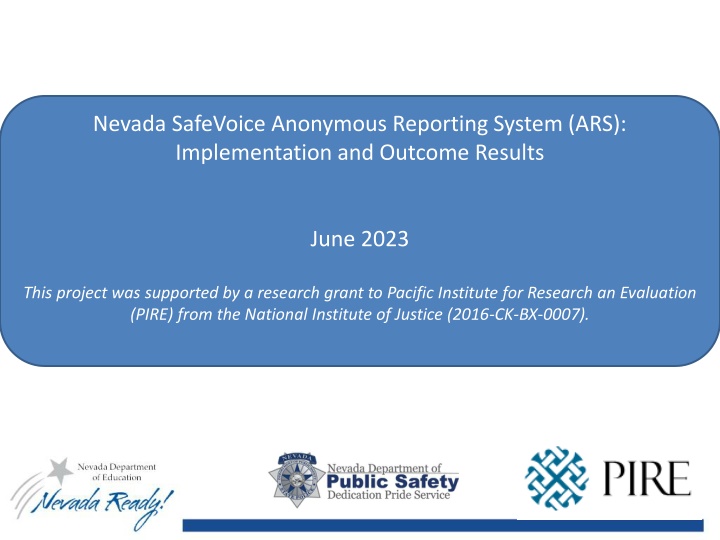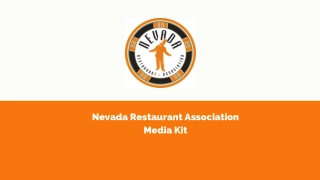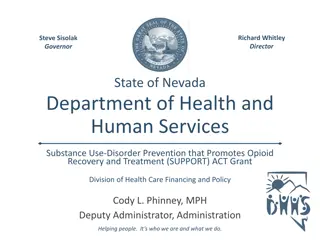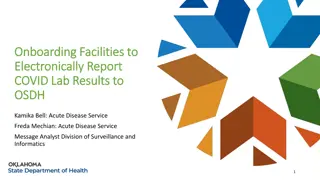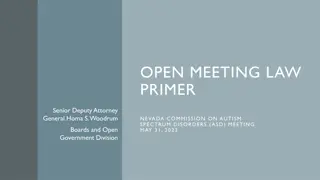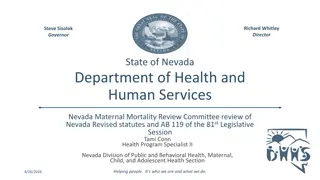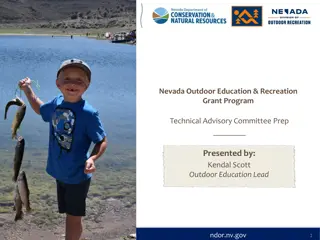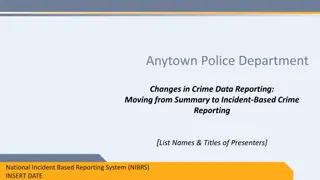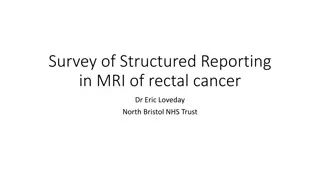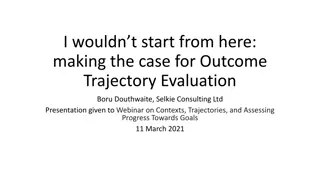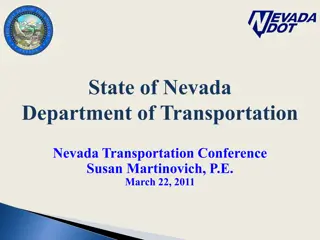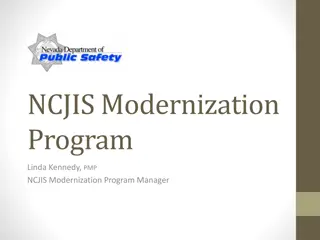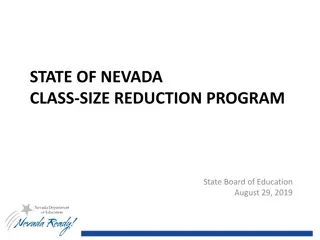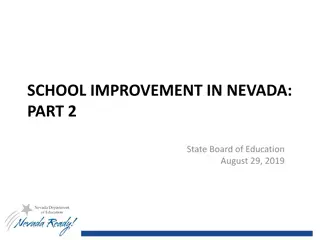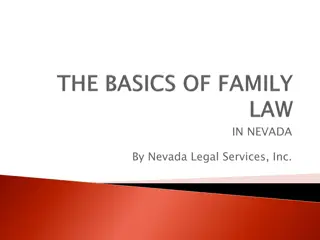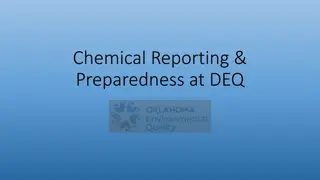Nevada SafeVoice Anonymous Reporting System: Implementation & Outcome Results
Established in 2015, the Nevada SafeVoice system enables anonymous reporting for students' safety. Managed by OSRLE & DPS, it serves public, charter, & private schools, promoting immediate responses & long-term follow-ups. This project, supported by a research grant, aims to assess the impact on student behaviors & school climate. Data from various sources will inform on implementation effectiveness & cost efficiency.
Download Presentation

Please find below an Image/Link to download the presentation.
The content on the website is provided AS IS for your information and personal use only. It may not be sold, licensed, or shared on other websites without obtaining consent from the author.If you encounter any issues during the download, it is possible that the publisher has removed the file from their server.
You are allowed to download the files provided on this website for personal or commercial use, subject to the condition that they are used lawfully. All files are the property of their respective owners.
The content on the website is provided AS IS for your information and personal use only. It may not be sold, licensed, or shared on other websites without obtaining consent from the author.
E N D
Presentation Transcript
Nevada SafeVoice Anonymous Reporting System (ARS): Implementation and Outcome Results June 2023 This project was supported by a research grant to Pacific Institute for Research an Evaluation (PIRE) from the National Institute of Justice (2016-CK-BX-0007).
Background Established in 2015 by the Nevada State Legislature (Nevada Revised Statute 388). Reports go to appropriate public agency (e.g., DPS, NDE, schools, local law enforcement) Anonymous reporting Agency can access personally identifiable information about the subject of the tip Each school must have a multidisciplinary team (MDT) that responds to tips Research grant from National Institute of Justice to PIRE in 2016 funded the planning, implementation, and evaluation of SafeVoice.
Background SafeVoice is overseen and managed by the Office for a Safe and Respectful Learning Environment (OSRLE) within Department of Education (NDE). Department of Public Safety (DPS) operates the 365/24/7 live communication center. SafeVoice operates in all public schools in all 17 school districts. Available in charter and private schools. Serves nearly 500,000 students and their families.
Components of SafeVoice Reporting Mobile app, mobile browser, web browser, phone Tip Dissemination Schools and local law enforcement (if necessary) Follow Up Immediate response Longer term follow up
Research Questions 1. How was SafeVoice implemented across the state? 2. What were the immediate responses to SafeVoice? 3. To what extent did SafeVoice reports prompt follow- up services for students of concern? 4. To what extent did the presence of SafeVoice contribute to changes in student behaviors and school climate? 5. How cost effective was SafeVoice in contributing to changes in student behaviors and school climate?
Data Sources Documents Meeting participation P3 reporting system (SafeVoice program data) Interviews and focus groups with MDTs, principals, school staff, parents, and students Data from Clark County school social workers School discipline data from Nevada Report Card Program cost data
Q1. How was SafeVoice implemented across the state? Planning phase from January to December of 2017. Development of procedures for reporting, tip dissemination, and follow up SafeVoice launched in half the schools in January 2018; Fully launched in August 2018. Research design - Half districts (and subdistricts in Clark and Washoe Counties) randomly assigned to Cohort 1 and Cohort 2 SafeVoice uses P3, licensed cloud-based software, to communicate with tipsters and store data NDE trained district staff in P3, reporting, and follow up DPS trained law enforcement agencies Marketing materials developed and disseminated
Q1. How was SafeVoice implemented across the state? NDE Hired full-time project coordinator Hired full time trainer Contributed substantial in-kind support (e.g., OSRLE Director and other staff) DPS Hired full-time coordinator Hired up to 12 communication specialists (three 8-hour shifts) Contributed substantial in-kind support (e.g., Deputy Director)
Number of Tips by Tip Type January 1, 2018 July 31, 2022 (n=27,226)
Top Ten Tips 1. Bullying 2. Suicide Threats 3. School/employee complaint 4. Threat to student 5. Planned school attack/threat to school 6. Cyberbullying 7. Drug abuse/drug distribution 8. Self-harm 9. Assault/battery 10. Harassment Bullying had almost twice as many tips as suicide threat (4,680 vs. 2,663).
Tips by Year and Month Tip volume decreased during summer Tip volume peaked each year at about 1,000 per month Tip volume decreased during COVID
Tips by Days of Week, Hour, and Mode Tips peaked Weds through Fridays Tips increased from 9:00am 2:00pm and were steady until 5:00pm High number of tips until 1:00am Equal number of tips through desktop browser, mobile browser, and mobile app
Life Safety Tips (n=458) 391 were suicide threats (8% of all suicide threats)
Life Safety Suicide Threats (n = 391) Most prevalent between 6:00pm and 1:00am, peaking at 1:00am Dramatic increase in fall of 2020 and fall of 2021 (post COVID)
Tips During COVID Substantial reductions in all tips except suicide threats and cyberbullying
Q2. What were the immediate responses to SafeVoice? Examined a small sample of tip types (i.e., suicide, bullying, threats to students, planned school attack, life safety tips) Data drawn from P3. Probably underreported, especially law enforcement actions. School-based actions were much more prevalent that law enforcement actions (as reported in P3).
Q2. What were the immediate responses to SafeVoice? For suicide threats, the most commonly reported school-based actions were parent contacted (62%), student check-in (48%), and school-based supports provided (29%). Similar actions were reported for life safety tips. For bullying, the commonly reported school-based actions were parent contacted (42%), bullying protocol engaged (35%), student check-in (28%), and school-based supports provided (21%). The most commonly reported law enforcement action occurred when responding to a school attack/threat to school. Of those tips, 40% involved a reported law enforcement investigation. Schools tip recipients reported that the rate of tips that were unfounded or had insufficient information ranged from 9.0% (life safety tips) to 42.7% (planned school attacks).
Q2. What were the immediate responses to SafeVoice? Examining data from all tips, law enforcement officers reported making arrests in 89 cases (0.3% of all tips) and giving out citations in 116 cases (0.4% of all tips). These low rates of reported arrest suggest that, even with a law enforcement-centric reporting system, punitive actions on the part of law enforcement agencies were rare.
Q3. To what extent did SafeVoice reports prompt follow-up services for students of concern? CCSD social workers reviewed 854 reports from 12 event types. Identified the student of concern in 748 cases (81%). Among the 748 reports with identifiable students, 642 had services provided to the students (86%). 31% were reported for suicide threat 27% for self-harm. Between 9% and 15% of the tips were for anger issues, drug abuse/drug distribution, and depression.
Q3. To what extent did SafeVoice reports prompt follow-up services for students of concern? Of the 642 known cases of students receiving services Referrals for counseling with an on-site agency (52%) Referrals for counseling with an outside agency (45%) Student check-ins (42%) Suicide protocols (21%) Suicide ideation procedures (8%) Student assessments (11%) A small, but not insubstantial, portion of the students were documented as receiving intensive services outside the domain of the schools Outpatient hospital services (3%), hospitalization (3%), Legal 2000 involuntary hold (3%), and in-patient hospital services (2%).
Q4. To what extent did the presence of SafeVoice contribute to changes in student behaviors and school climate? Why would SafeVoice lead to changes in behaviors and better school climates? Prevention/ early intervention Deterrence
Methods PIRE analyzed monthly data for the following variables for 2014/15 to 2020/21: Violence to other students* Violence to school staff* Bullying* Cyberbullying* Possession of weapons* Youth suicide** We created statistical models that compared the estimated trends in the absence of SafeVoice with the actual trends after the initiation of SafeVoice. * Nevada Report Card by school ** National Center for Health Statistics by county
Reductions in violence against staff (32% or 485 cases) Reductions in possession of weapons (32% or 511 cases) No effects for bullying, cyberbullying, violence against students, suicide
School Climate/SEL Survey After initial decrease in school climate, Cohort 1 schools rebounded in Spring of 2019. Overall increases in school climate in 2019 which coincided with full launch of SafeVoice.
Q5. How cost effective was SafeVoice in contributing to changes in student behaviors and school climate? We estimated that the costs of operating SafeVoice at the state level from 2017 2019 totaled $2.49 million dollars (including grant funding and in-kind staffing support from the State). Using published average costs per incident, we estimated that savings associated with our estimates of 485 prevented incidents of violence against staff and 511 prevented incidents of weapons possession totaled $34 million. Thus, every dollar spent on the State s operation of SafeVoice saved $13.80 in identifiable prevented events, including $3.45 in direct out-of-pocket costs.
Lessons Learned A well-managed and well-publicized ARS will be used by students and others, as evidenced by the 27,000 tips received by SafeVoice. Communications specialists and local responders must be adequately prepared to vet, triage, and respond to a diverse set of tips. The resources and staffing needed to adequately plan for and implement a 365/24/7 tip line are substantial. Even with a robust data system (P3), the data are marred by underreporting, especially by law enforcement. ARS can lead to cost savings, as illustrated by the estimated $13.80 saved on every statewide dollar spent on reductions in violence to staff and possession of weapons alone, including $3.45 in direct out-of-pocket costs. Despite early misgivings, SafeVoice was largely seen as a valuable resource by school staff and students.
Unanswered Questions What are the experiences of law enforcement agencies and officers in responding to SafeVoice? To what extent do SafeVoice tips lead to school- based vs. law enforcement responses? To what extend does SafeVoice lead to unintended consequences, especially for communities of color? To what extent does SafeVoice save lives?
For More Information Al Stein-Seroussi, PhD PIRE 919-265-2616 stein@pire.org
